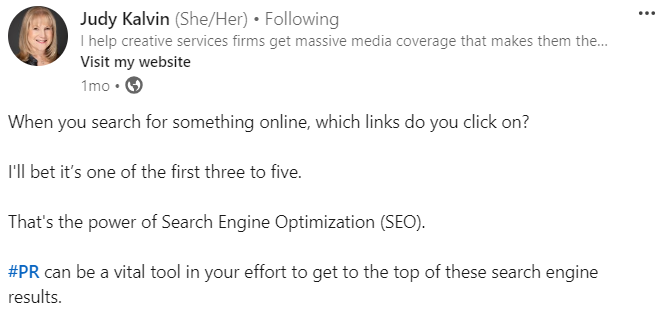In public relations, effective communication and storytelling have always been key. But let’s take a moment to acknowledge how much the media landscape has changed. Technology is advancing at lightning speed, and consumer behaviors are evolving just as fast.
What does this mean for PR pros? These changes, along with greater influence with the C-suite, have created a host of new challenges and exciting opportunities for PR teams – both of which require a more diverse, tech-savvy skill set to thrive.
That’s what we’re looking at here – what are those must-have skills?
1. Data Analysis
Today’s PR teams are data-driven, and for good reason. Analyzing and interpreting data has become crucial to managing brand reputation, reaching the right audiences, and proving your impact on business goals.
Sarah O’Grady, SVP of marketing for Cision and Brandwatch, sums it up perfectly:
PR’s increasing reliance on data and analytics...will ultimately make PR and corporate comms teams more effective at their jobs, as they derive a better understanding of who their audiences actually are, what matters most to them, and how to deliver that in a streamlined, memorable way.
Our 2024 Global Comms Report found that 42% of comms leaders are relying on data and analytics more than ever. But here’s the kicker - over half still struggle to effectively measure their impact. Sound familiar? With so many digital platforms and analytics tools, there’s a ton of data out there - the challenge is making sense of it all.
Key Areas of Focus
Some key areas for PR pros to focus on include:
- Channel & Message Effectiveness: Which channels work best for your content? How do different messages perform? Analyze the data and answer these questions to refine your approach and boost your reach.
- Sentiment Analysis: What’s the public saying about your brand? Monitor public opinion about your brand, products, and services to proactively manage reputation and prevent crises. Advanced tools, like CisionOne, can provide greater context than standard sentiment - flagging harmful content, identifying what’s driving public opinion, etc.
- Trend Identification: Spot emerging topics in your industry. These provide opportunities for your brand to add to the conversation with thought leadership.
- Campaign Performance & ROI Measurement: Track key metrics and link your efforts to business outcomes. This analysis informs future strategy and helps prove the value of your work to leadership.
Take a deeper dive into PR measurement with these resources:
2. Social Media Strategy
Social media platforms are constantly changing, and it’s beyond crowded out there, so simply having a presence isn't enough.
PR pros need to know how to stand out on social, but just as important, who is influencing the conversation and how to partner with them effectively. Even the role of influencers - and who gets that label - has changed drastically in the last few years. Our Global Comms Report noted that influencer management has become a top priority for nearly half of comms leaders worldwide.
Our director of social media at Cision and Brandwatch, Meghan Meeker, reiterates the importance of social media in today’s digital environment:
Social media proficiency is no longer an optional skill for PR professionals, but a powerful must-have. From partnering with influencers and interacting with customers to building relationships with reporters, social media has become an essential part of PR. Brands should always use social media as it was intended – to create genuine, authentic connections.
Key Areas of Focus
PR pros should focus attention on these areas:
- Platform Nuances: Each social media platform is unique. You’ll want to tailor your message, content, and multimedia accordingly.
- Influencer Collaboration: Find and partner with influencers who align with your brand values and can authentically reach your audience.
- Social Media Listening and Monitoring: This involves 'listening' to the conversation about your brand on social media and tracking the effectiveness of social campaigns. You can do this manually by looking at metrics like follower count growth, likes, comments, etc. or with the help of a tool like CisionOne, which will provide deeper insights, at scale, in a fraction of the time.
For more on social media in PR, check out these resources:
- The Art of Social PR: The Complete Guide to Social Listening for PR
- PR in the Age of Misinformation: Building and Maintaining Brand Trust
3. Artificial Intelligence
As AI continues to transform various industries, public relations is no exception. The industry has leveraged AI for years for things like sentiment analysis, but the technology is advancing quickly. As AI adoption continues to grow, it won’t be able to replace your creativity or strategic thinking, but it can enhance your efficiency and effectiveness.
Here’s a stat that might surprise you: 32% of PR and comms leaders are already using generative AI regularly (Global Comms Report). What are they using it for? Content creation and optimization top the list, but that’s just scratching the surface of what’s possible.
Current Use of Generative AI Tools By Comms

If you’ve been holding off on experimenting with AI in your workflows, consider this advice from Ant Cousins, executive director of AI strategy at Cision:
Key Areas of Focus
Key areas of AI application in PR include:
- Content Creation and Optimization: Use AI-powered tools to draft and optimize content for different channels and audiences.
- Media Monitoring and Analysis: Process vast amounts of data for real-time insights on brand mentions, sentiment, and industry trends.
- Multimedia Creation: Use AI to enhance your PR content with visuals, videos, and other multimedia.
- Research and Brainstorming: Gather and analyze information quickly to generate fresh campaign ideas.
Reference these resources for more details on AI in PR:
- From AI to Z: A Starter Guide to Using Generative AI in PR & Comms
- Leveraging AI in Public Relations: A Guide for Brands Navigating Cancel Culture
4. Search Engine Optimization (SEO)
In today's digital-first world, your brand’s online presence is everything. A working knowledge of SEO is no longer optional for PR pros. It's essential.
Here's why: SEO isn't just about search rankings. It's about creating awareness for your brand and amplifying your messaging. With high-quality content and strategic publication targeting, you can significantly boost organic traffic to your brand's website.

Key Areas of Focus
A working knowledge of SEO includes these fundamentals:
- Keyword Research: Identify relevant keywords and naturally incorporate them into your content (e.g., press releases, blog posts, newsroom).
- On-Page Optimization: Master the best practices for optimizing headlines, meta descriptions, and content structure.
- Link Building: Understanding the power of quality backlinks and how to earn them through PR activities.
- Local SEO: For PR pros working with businesses that have a physical presence, understanding the nuances of local SEO strategies is critical.
- SEO Tools: Familiarize yourself with tools like Google Analytics, Google Search Console, and Ahrefs to track and improve your efforts.
For more on SEO and digital trends, here are a few resources:
5. Crisis Planning/Management
In today's 24/7 digital environment, a crisis can emerge in minutes. Here’s a sobering fact: Only 21% of communications leaders feel confident in preventing crises before they happen (Global Comms Report). But it doesn’t have to be this way. With proper planning and an “always on” approach, you can spot issues before they take hold.
Remember, information spreads like wildfire and the impacts can be significant. We’ve seen this play out with major brands more and more. In fact, Molly McPherson, a well-known (and highly entertaining) crisis management pro, just underscored this point in her recent video on TikTok.
Key Areas of Focus
Crisis planning and management is complicated, but these are some of the musts:
- Risk Assessment: Identify potential crisis scenarios and evaluate their likelihood and impact.
- Crisis Plan Development: Create comprehensive plans outlining roles and responsibilities, and procedures for various scenarios.
- Rapid Response Protocols: Establish systems for quick decision-making and communication during a crisis, including approval processes and messaging templates.
- Stakeholder Mapping: Identify key stakeholders and understand their concerns and communication preferences.
- Media Training: Prepare spokespeople for crisis interviews and press conferences.
- Crisis Management: Understanding how to manage crises across digital platforms, including monitoring, responding, and mitigating online reputation damage.
More info on crisis planning and management:
The Only Constant is Change
The media landscape is evolving. Technology is advancing. Consumer behaviors are shifting. For PR pros, this means both challenges and opportunities. Strong communication skills and strategic thinking will always be the foundation of great PR. But in today's ever-changing, complicated environment, we all need to continuously adapt and expand our abilities to stay ahead.
Want to learn more about how CisionOne can help? Let's talk.








